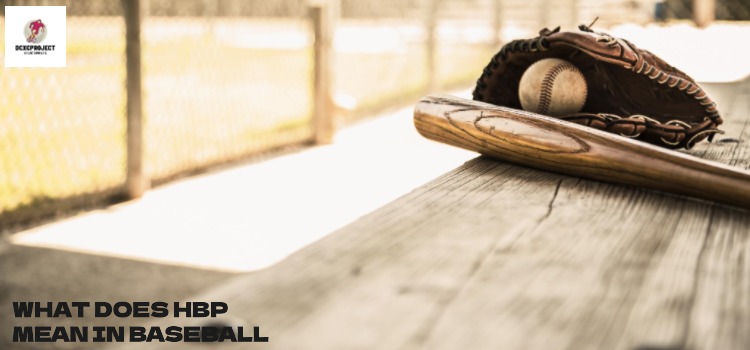What Does HBP Mean in Baseball? HBP stands for Hit By Pitch, a term used when a batter is struck by a pitched ball without swinging at it. This usually results in the batter being awarded first base.
Understanding the nuances of baseball statistics can significantly enhance a fan’s viewing experience. HBP, or hit by pitch, is one such statistic that plays a critical role in the flow of the game. It occurs when a pitcher throws a ball that hits the batter’s body, leading to an automatic walk to first base.
This not only grants the offensive team a base runner but can also shift the momentum within an inning. It is essential for pitchers to maintain control over their pitches to avoid these potentially game-altering mistakes. Batters, on the other hand, need to exhibit quick reflexes to evade pitches heading their way, although sometimes getting HBP can be a strategic move to get on base. The rule behind HBP is fundamental and contributes to the strategic depth of baseball.
The Significance Of Hbp In Baseball
Hit By Pitch (HBP) is a term in baseball that refers to a batter being hit by a pitch thrown by the pitcher. This event has more layers of significance than one might initially think, affecting not only the game’s outcome but also the strategies and player dynamics on the field. Understanding HBP unravels the intricate balance between risk and reward that teams navigate throughout the baseball season.
Impact On Player Performance
When a batter receives an HBP, it can influence their performance in various ways. For one, it grants them a free pass to first base, potentially disrupts the pitcher’s rhythm, and alters the overall tempo of the game. This can bring a psychological edge, turning the tides in favor of the batting team. However, it can also lead to physical repercussions for the player, risking injury and affecting their ability to play in subsequent games.
The frequency of HBP also serves as a submerged iceberg tip in player statistics. A player with a high HBP rate might exhibit a closer stance to the plate or a knack for not evading pitches, both of which can be valuable traits for reaching base more often. Unraveling these hidden stats further:
- On-base percentage: A hit by pitch counts towards a batter’s on-base percentage (OBP), marking a player’s proficiency in reaching base.
- Strategic advantage: Teams sometimes use HBP to their strategic advantage, with skilled players turning their knack for getting hit into a tactical edge.
- Warning to pitchers: A player often hit by pitches might signal pitchers to steer clear of the inside of the plate, effectively broadening the hitting zone for the batter.
Historical Context Of Hbp
Historically, HBP has seen a wide array of contexts within the sport of baseball. From aggressive pitching strategies to the infamous ‘brushback’, HBP instances highlight the evolution of pitching and batting techniques over the decades.
In the past, certain teams or pitchers were notorious for using HBP as an intimidation tactic, sending a clear yet unsaid message to opposing teams and players. In terms of statistics:
| Year | Notable HBP Event |
|---|---|
| 1920 | Implementation of rules due to fatal HBP (Ray Chapman’s death) |
| 1967 | Tony Conigliaro’s career altered by a severe HBP injury |
| 2004 | Jason Kendall sets the modern record for HBPs in a season |
The table illustrates pivotal moments linking HBP with broader evolutions in the sport’s safety regulations and cultural attitudes.
Today, though HBP is monitored more closely with advanced protective gear and stringent rules protecting players, it continues to be an integral aspect shaping the game’s strategy and highlighting the courage and resilience of players. As we peek into the past and assess the present, HBP’s role in baseball remains as significant as ever, a testament to the game’s changing face and the timeless challenge it poses to players stepping up to the plate.

Understanding The Rules And Statistics
When diving into the tactical world of baseball, it’s not just home runs and strikeouts that draw attention. Hidden within the complex rulebook and a myriad of statistics is a term that has significant implications for both players and teams: HBP. Understanding the rules and statistics surrounding HBP can offer a profound insight into the strategic nuances of the game.
Definition Of Hbp
HBP stands for “Hit By Pitch,” a term applied when a batter is struck by a pitched ball without swinging at it and is not in the strike zone. When this occurs, the batter is awarded first base. HBP is a critical component of a batter’s on-base percentage (OBP) and encapsulates a pitcher’s control over their pitches.
How Hbp Affects The Game
The consequences of an HBP event reach further than a mere base advancement. Here are the ways in which HBP impacts the game:
- Strategic Advantage: Teams may use HBP to gain a tactical edge, as it can disrupt a pitcher’s rhythm or retaliate for a previous HBP.
- On-Base Opportunities: For batters, being hit by a pitch creates an opportunity to reach base without hitting the ball, potentially leading to runs scored.
- Statistical Impact: HBP can affect a player’s statistics such as OBP and a pitcher’s WHIP (Walks plus Hits per Inning Pitched).
- Injury Risk: There’s an inherent risk of injury to the batter, which can affect player health and team strategy.
An HBP incident involves careful scrutiny; umpires must determine whether the batter made an adequate effort to avoid being hit. This judgment call can influence the pace and momentum of the game. Moreover, repeated HBPs can lead to warnings, ejections, or suspensions, further altering team dynamics and long-term strategies.
Tracking HBP statistics can reveal patterns in pitching behavior or batters’ tendencies to occupy space over the plate. These insights can inform coaching decisions and player development. Thus, HBP is not just about the immediate effect on base advancement but also an important strategic element woven into the fabric of baseball’s analytical tapestry.
Strategies And Repercussions
In the fascinating world of baseball, HBP (Hit By Pitch) is not just an incidental occurrence but an event loaded with tactical depth and potential consequences. When a batter is struck by a pitched ball without swinging at it, the play can shift the momentum of the game, influencing team dynamics and individual performances. Exploring the strategies behind HBP and its repercussions sheds light on the chess-like nature of baseball, where every move counts and the stakes are always high.
Pitcher And Hitter Perspectives
The encounter between the pitcher and hitter is a high-stakes duel where an HBP can be a deliberate tactic or an unintended mistake. From the pitcher’s stance, an HBP might be a calculated move to unsettle a hitter’s rhythm or claim dominance on the diamond. The hitter, aware of such tactics, might wear protective gear or adopt a batting stance that reduces the risk of injury while maintaining the ability to react swiftly to a pitch.
In-game Strategies For Hbp
Applying strategic HBP in-game demands a nuanced understanding of the current score, inning, and player matchups. Managers and pitchers deliberate over these critical decisions:
- Intentional Walk Substitution: An HBP can serve as a substitute for an intentional walk, particularly when facing a strong hitter with bases already occupied.
- Gaining a Psychological Edge: Brushing back a hitter can disrupt their focus, making them more susceptible to mistakes.
- Pace Control: An HBP can break the rhythm of the game, providing the defensive team a moment to regroup and strategize.
Nevertheless, the ramifications of HBP can’t be ignored:
- Injury Risk: HBP inherently carries the threat of physical harm to the hitter, which can affect player health and team rosters.
- Retaliatory Measures: An HBP might ignite tensions, leading to potential retaliation that escalates into conflicts, affecting player concentration and performance.
- Base Advancement: A hit batter is awarded first base, often bolstering the offensive team’s position with an extra base runner.
Safety Concerns And Controversies
In the world of baseball, HBP or “Hit By Pitch” refers to an event where a batter gets struck by a pitched ball without swinging at it. While a HBP can be an effective strategic move, instantly putting a player on base, it raises safety concerns and controversies that spark heated debates within the baseball community. Balancing the intricate dance between competitive tactics and players’ well-being, the sport continues to evaluate and address the risks associated with being hit by pitches.
Player Safety And Protective Gear
Ensuring player safety in baseball is paramount. With fastballs reaching speeds upwards of 100 mph, being hit by a pitch can lead to serious injuries. The use of protective gear has been a significant step forward in reducing the risk of harm. Batters often wear helmets with face guards, elbow guards, shin guards, and padded gloves as precautionary measures. These essential pieces of equipment shield vulnerable areas and dissipate the force of impact, allowing players to step up to the plate with confidence, knowing they have a level of protection against potential accidents.
Debate Surrounding Intentional Hbp
The practice of intentionally hitting a batter with a pitch—whether as a form of retaliation, to send a message, or to remove a strong player from scoring position—has been a longstanding controversial issue. Deliberate HBP not only rattles the sportsmanship spirit but also escalates the risk of severe injuries. Major League Baseball has rules in place to deter pitchers from intentionally throwing at batters, including potential ejections and suspensions. However, the subjective nature of determining intent often leads to intense debates among players, coaches, umpires, and fans. It remains a contentious topic, weighing the strategic component of the game against the ethical consideration and respect for fellow athletes’ safety.

Frequently Asked Questions On What Does Hbp Mean In Baseball
Does A Hbp Count As A Walk?
A hit by pitch (HBP) does not count as a walk. Both award the batter first base, but they’re recorded differently in baseball statistics.
Does Hbp Count As An At Bat?
No, a hit by pitch (HBP) does not count as an at-bat in baseball statistics. It does contribute to a player’s on-base percentage (OBP).
Who Has The Highest Hbp In Mlb?
Hughie Jennings holds the MLB record for the most hit by pitches, with 287 during his career.
Is It A Walk If Pitcher Hits The Batter?
No, a walk is not awarded if a pitcher hits the batter. The batter gets a base if hit by a pitch, separate from a walk.
Conclusion
Understanding HBP in baseball enriches your appreciation for the game’s strategic nuances. It highlights a player’s resilience and a pitcher’s tactical edge. Baseball enthusiasts and statisticians alike track HBP as it subtly influences game outcomes and player statistics. So next time HBP pops up, you’ll grasp its impact on the diamond.

